Analysis of Market Structures in Australia's Supermarket and Telecom
VerifiedAdded on 2023/06/12
|7
|1585
|418
Report
AI Summary
This report provides an economic analysis of Australia's supermarket and telecommunication sectors, focusing on the presence of oligopolistic and monopolistic market structures. It highlights the dominance of a few key players like Woolworths, Coles, and Telstra, and their impact on competition and consumer prices. The report discusses the characteristics of oligopolies and monopolies, such as interdependence among firms, barriers to market entry, and the potential for collusion. It also examines the role of government in promoting fair competition through the Australian Competition Commission. The report concludes with recommendations for enhancing competition and protecting consumer interests in these vital sectors of the Australian economy. Desklib provides access to similar reports and study tools for students.
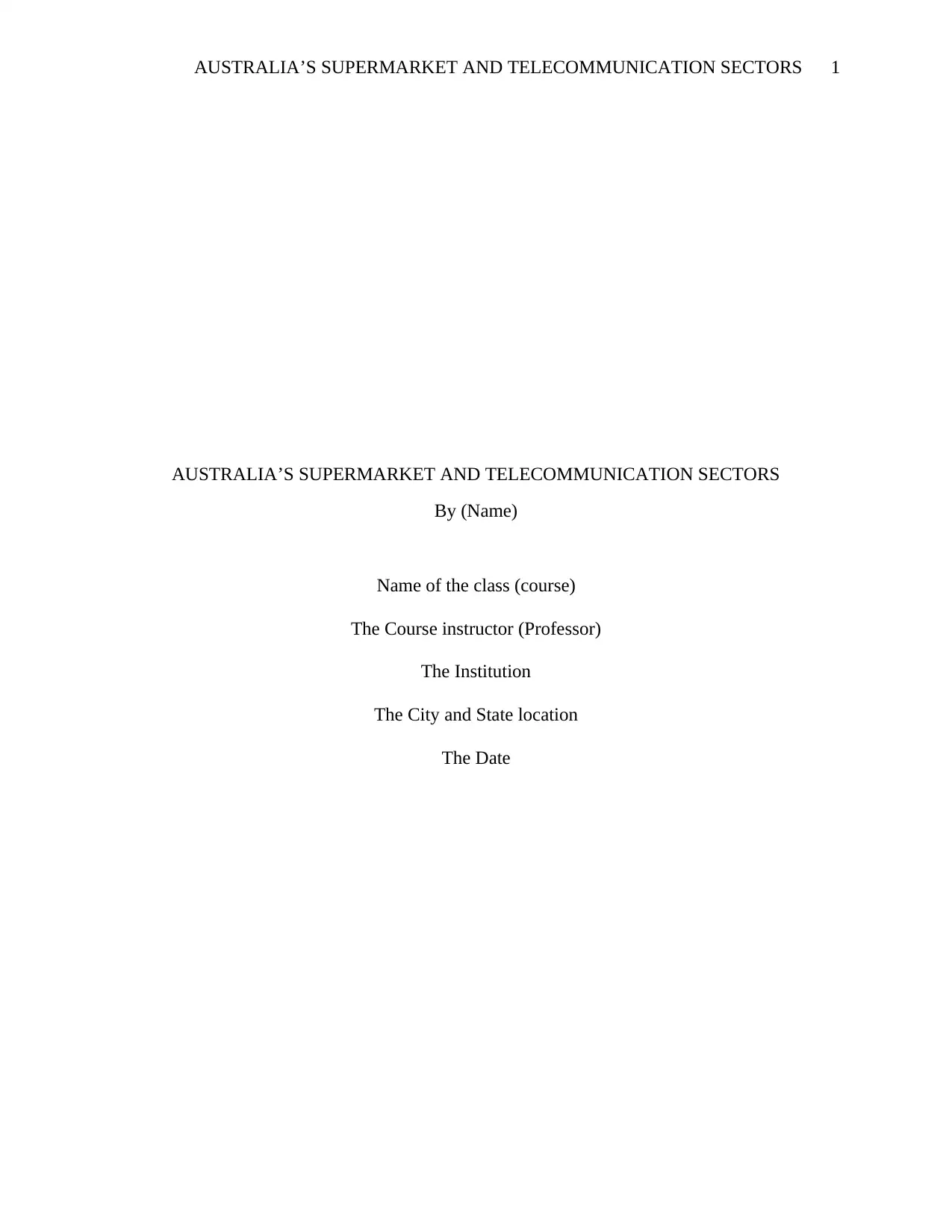
AUSTRALIA’S SUPERMARKET AND TELECOMMUNICATION SECTORS 1
AUSTRALIA’S SUPERMARKET AND TELECOMMUNICATION SECTORS
By (Name)
Name of the class (course)
The Course instructor (Professor)
The Institution
The City and State location
The Date
AUSTRALIA’S SUPERMARKET AND TELECOMMUNICATION SECTORS
By (Name)
Name of the class (course)
The Course instructor (Professor)
The Institution
The City and State location
The Date
Paraphrase This Document
Need a fresh take? Get an instant paraphrase of this document with our AI Paraphraser
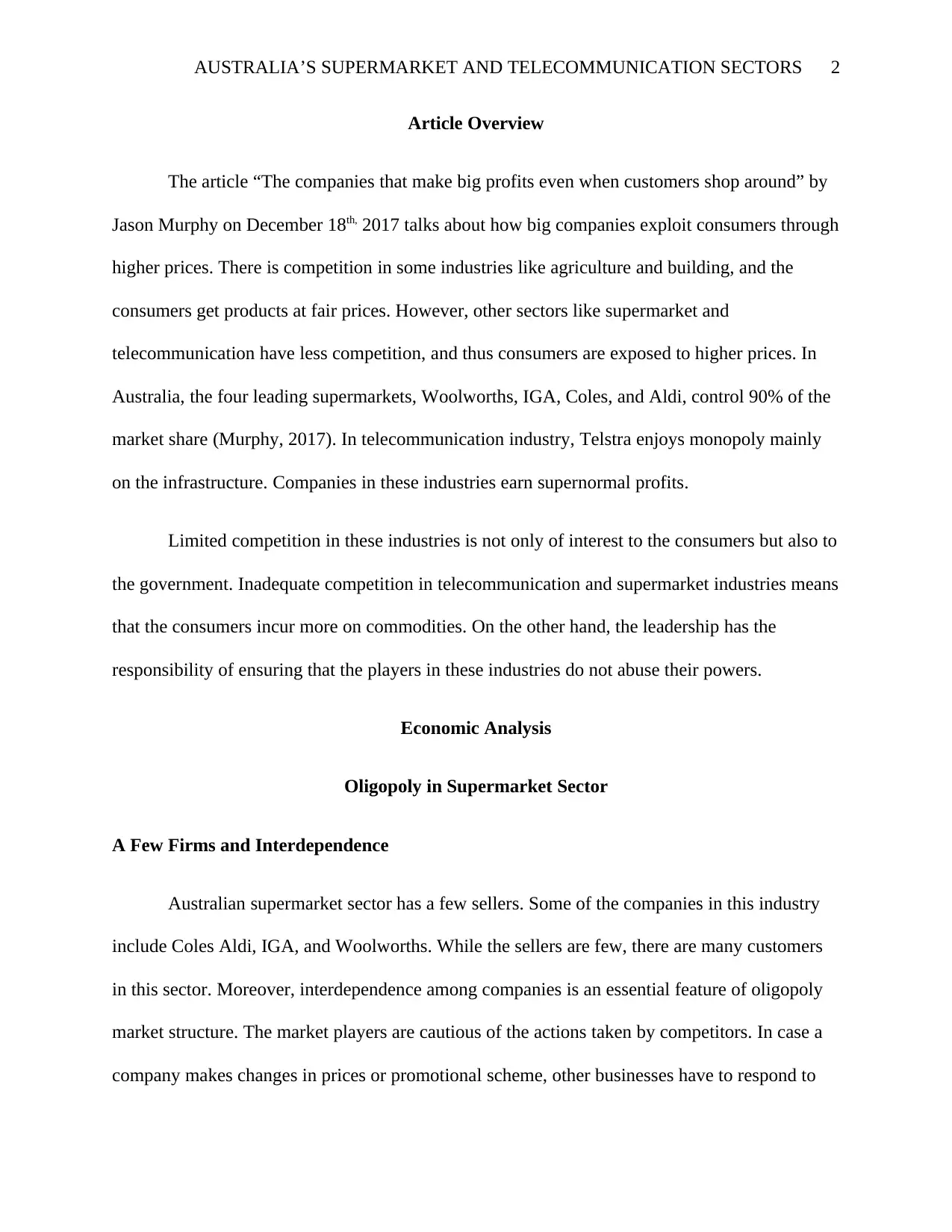
AUSTRALIA’S SUPERMARKET AND TELECOMMUNICATION SECTORS 2
Article Overview
The article “The companies that make big profits even when customers shop around” by
Jason Murphy on December 18th, 2017 talks about how big companies exploit consumers through
higher prices. There is competition in some industries like agriculture and building, and the
consumers get products at fair prices. However, other sectors like supermarket and
telecommunication have less competition, and thus consumers are exposed to higher prices. In
Australia, the four leading supermarkets, Woolworths, IGA, Coles, and Aldi, control 90% of the
market share (Murphy, 2017). In telecommunication industry, Telstra enjoys monopoly mainly
on the infrastructure. Companies in these industries earn supernormal profits.
Limited competition in these industries is not only of interest to the consumers but also to
the government. Inadequate competition in telecommunication and supermarket industries means
that the consumers incur more on commodities. On the other hand, the leadership has the
responsibility of ensuring that the players in these industries do not abuse their powers.
Economic Analysis
Oligopoly in Supermarket Sector
A Few Firms and Interdependence
Australian supermarket sector has a few sellers. Some of the companies in this industry
include Coles Aldi, IGA, and Woolworths. While the sellers are few, there are many customers
in this sector. Moreover, interdependence among companies is an essential feature of oligopoly
market structure. The market players are cautious of the actions taken by competitors. In case a
company makes changes in prices or promotional scheme, other businesses have to respond to
Article Overview
The article “The companies that make big profits even when customers shop around” by
Jason Murphy on December 18th, 2017 talks about how big companies exploit consumers through
higher prices. There is competition in some industries like agriculture and building, and the
consumers get products at fair prices. However, other sectors like supermarket and
telecommunication have less competition, and thus consumers are exposed to higher prices. In
Australia, the four leading supermarkets, Woolworths, IGA, Coles, and Aldi, control 90% of the
market share (Murphy, 2017). In telecommunication industry, Telstra enjoys monopoly mainly
on the infrastructure. Companies in these industries earn supernormal profits.
Limited competition in these industries is not only of interest to the consumers but also to
the government. Inadequate competition in telecommunication and supermarket industries means
that the consumers incur more on commodities. On the other hand, the leadership has the
responsibility of ensuring that the players in these industries do not abuse their powers.
Economic Analysis
Oligopoly in Supermarket Sector
A Few Firms and Interdependence
Australian supermarket sector has a few sellers. Some of the companies in this industry
include Coles Aldi, IGA, and Woolworths. While the sellers are few, there are many customers
in this sector. Moreover, interdependence among companies is an essential feature of oligopoly
market structure. The market players are cautious of the actions taken by competitors. In case a
company makes changes in prices or promotional scheme, other businesses have to respond to
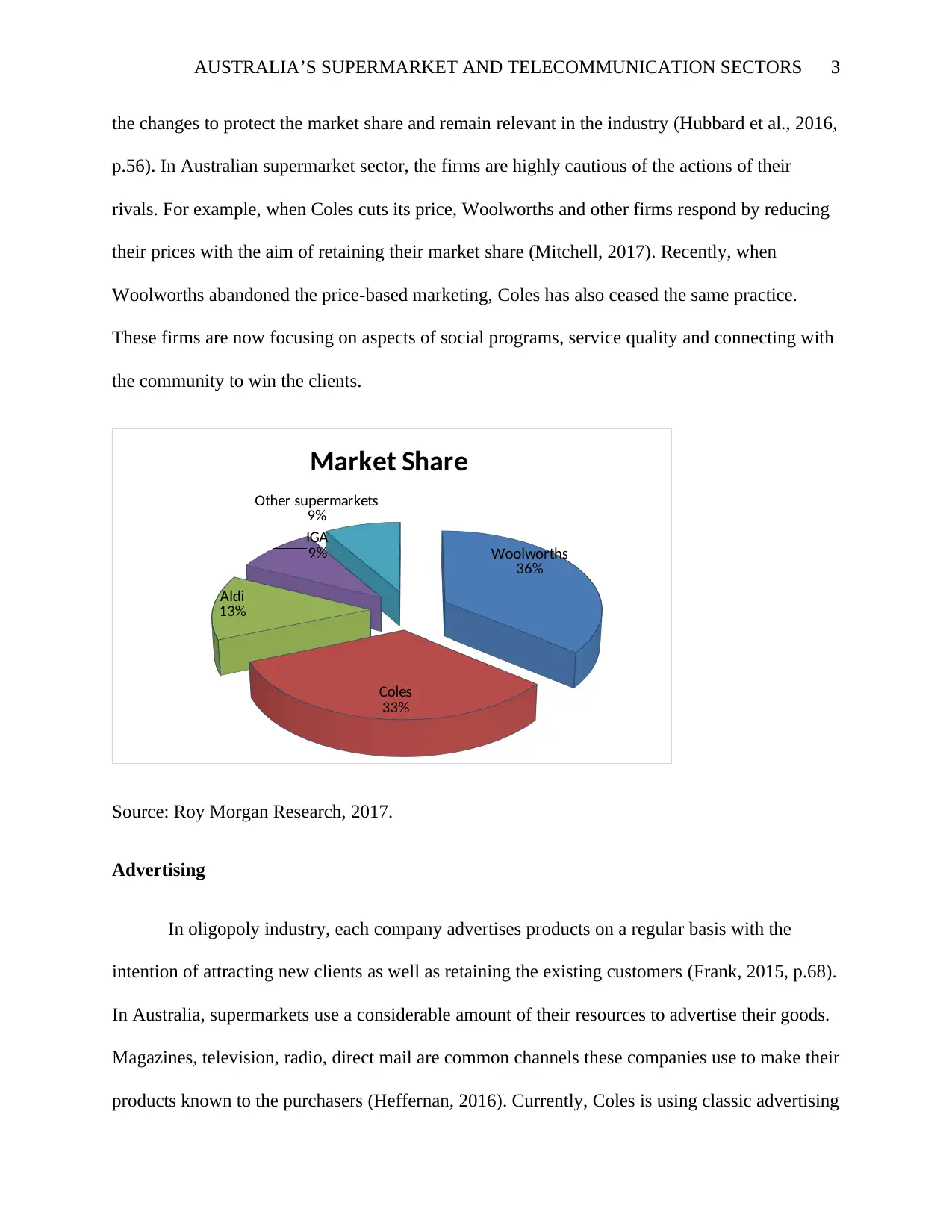
AUSTRALIA’S SUPERMARKET AND TELECOMMUNICATION SECTORS 3
the changes to protect the market share and remain relevant in the industry (Hubbard et al., 2016,
p.56). In Australian supermarket sector, the firms are highly cautious of the actions of their
rivals. For example, when Coles cuts its price, Woolworths and other firms respond by reducing
their prices with the aim of retaining their market share (Mitchell, 2017). Recently, when
Woolworths abandoned the price-based marketing, Coles has also ceased the same practice.
These firms are now focusing on aspects of social programs, service quality and connecting with
the community to win the clients.
Woolworths
36%
Coles
33%
Aldi
13%
IGA
9%
Other supermarkets
9%
Market Share
Source: Roy Morgan Research, 2017.
Advertising
In oligopoly industry, each company advertises products on a regular basis with the
intention of attracting new clients as well as retaining the existing customers (Frank, 2015, p.68).
In Australia, supermarkets use a considerable amount of their resources to advertise their goods.
Magazines, television, radio, direct mail are common channels these companies use to make their
products known to the purchasers (Heffernan, 2016). Currently, Coles is using classic advertising
the changes to protect the market share and remain relevant in the industry (Hubbard et al., 2016,
p.56). In Australian supermarket sector, the firms are highly cautious of the actions of their
rivals. For example, when Coles cuts its price, Woolworths and other firms respond by reducing
their prices with the aim of retaining their market share (Mitchell, 2017). Recently, when
Woolworths abandoned the price-based marketing, Coles has also ceased the same practice.
These firms are now focusing on aspects of social programs, service quality and connecting with
the community to win the clients.
Woolworths
36%
Coles
33%
Aldi
13%
IGA
9%
Other supermarkets
9%
Market Share
Source: Roy Morgan Research, 2017.
Advertising
In oligopoly industry, each company advertises products on a regular basis with the
intention of attracting new clients as well as retaining the existing customers (Frank, 2015, p.68).
In Australia, supermarkets use a considerable amount of their resources to advertise their goods.
Magazines, television, radio, direct mail are common channels these companies use to make their
products known to the purchasers (Heffernan, 2016). Currently, Coles is using classic advertising
⊘ This is a preview!⊘
Do you want full access?
Subscribe today to unlock all pages.

Trusted by 1+ million students worldwide
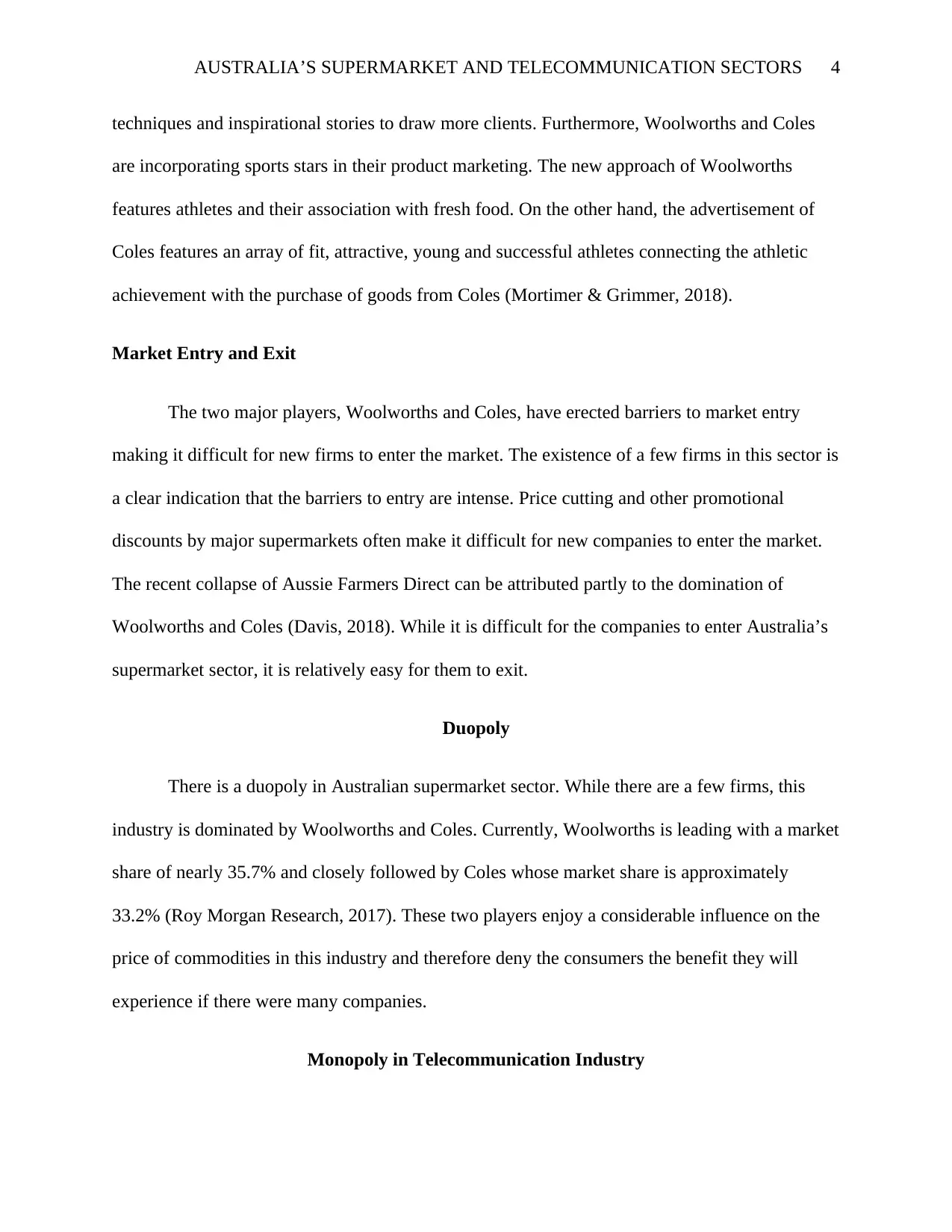
AUSTRALIA’S SUPERMARKET AND TELECOMMUNICATION SECTORS 4
techniques and inspirational stories to draw more clients. Furthermore, Woolworths and Coles
are incorporating sports stars in their product marketing. The new approach of Woolworths
features athletes and their association with fresh food. On the other hand, the advertisement of
Coles features an array of fit, attractive, young and successful athletes connecting the athletic
achievement with the purchase of goods from Coles (Mortimer & Grimmer, 2018).
Market Entry and Exit
The two major players, Woolworths and Coles, have erected barriers to market entry
making it difficult for new firms to enter the market. The existence of a few firms in this sector is
a clear indication that the barriers to entry are intense. Price cutting and other promotional
discounts by major supermarkets often make it difficult for new companies to enter the market.
The recent collapse of Aussie Farmers Direct can be attributed partly to the domination of
Woolworths and Coles (Davis, 2018). While it is difficult for the companies to enter Australia’s
supermarket sector, it is relatively easy for them to exit.
Duopoly
There is a duopoly in Australian supermarket sector. While there are a few firms, this
industry is dominated by Woolworths and Coles. Currently, Woolworths is leading with a market
share of nearly 35.7% and closely followed by Coles whose market share is approximately
33.2% (Roy Morgan Research, 2017). These two players enjoy a considerable influence on the
price of commodities in this industry and therefore deny the consumers the benefit they will
experience if there were many companies.
Monopoly in Telecommunication Industry
techniques and inspirational stories to draw more clients. Furthermore, Woolworths and Coles
are incorporating sports stars in their product marketing. The new approach of Woolworths
features athletes and their association with fresh food. On the other hand, the advertisement of
Coles features an array of fit, attractive, young and successful athletes connecting the athletic
achievement with the purchase of goods from Coles (Mortimer & Grimmer, 2018).
Market Entry and Exit
The two major players, Woolworths and Coles, have erected barriers to market entry
making it difficult for new firms to enter the market. The existence of a few firms in this sector is
a clear indication that the barriers to entry are intense. Price cutting and other promotional
discounts by major supermarkets often make it difficult for new companies to enter the market.
The recent collapse of Aussie Farmers Direct can be attributed partly to the domination of
Woolworths and Coles (Davis, 2018). While it is difficult for the companies to enter Australia’s
supermarket sector, it is relatively easy for them to exit.
Duopoly
There is a duopoly in Australian supermarket sector. While there are a few firms, this
industry is dominated by Woolworths and Coles. Currently, Woolworths is leading with a market
share of nearly 35.7% and closely followed by Coles whose market share is approximately
33.2% (Roy Morgan Research, 2017). These two players enjoy a considerable influence on the
price of commodities in this industry and therefore deny the consumers the benefit they will
experience if there were many companies.
Monopoly in Telecommunication Industry
Paraphrase This Document
Need a fresh take? Get an instant paraphrase of this document with our AI Paraphraser
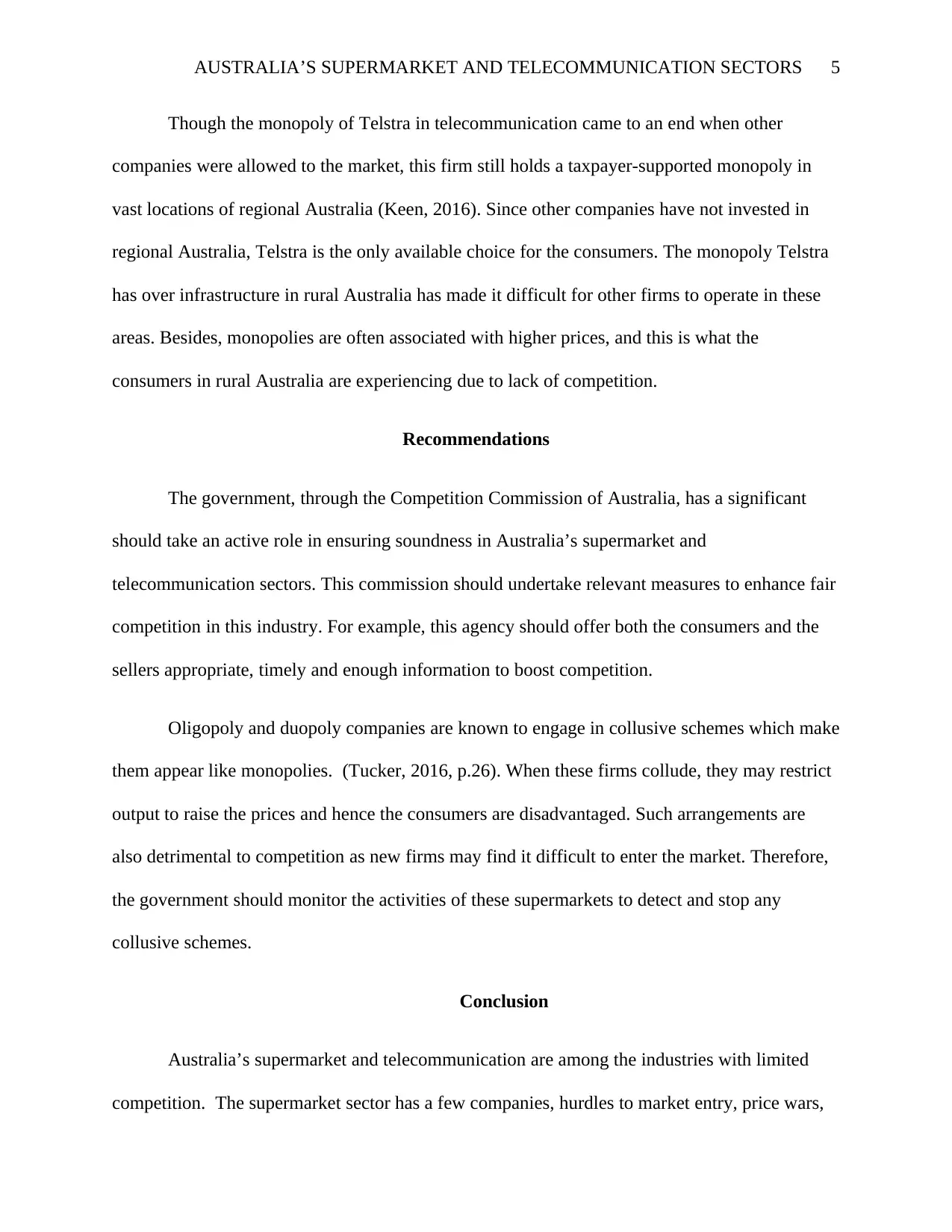
AUSTRALIA’S SUPERMARKET AND TELECOMMUNICATION SECTORS 5
Though the monopoly of Telstra in telecommunication came to an end when other
companies were allowed to the market, this firm still holds a taxpayer-supported monopoly in
vast locations of regional Australia (Keen, 2016). Since other companies have not invested in
regional Australia, Telstra is the only available choice for the consumers. The monopoly Telstra
has over infrastructure in rural Australia has made it difficult for other firms to operate in these
areas. Besides, monopolies are often associated with higher prices, and this is what the
consumers in rural Australia are experiencing due to lack of competition.
Recommendations
The government, through the Competition Commission of Australia, has a significant
should take an active role in ensuring soundness in Australia’s supermarket and
telecommunication sectors. This commission should undertake relevant measures to enhance fair
competition in this industry. For example, this agency should offer both the consumers and the
sellers appropriate, timely and enough information to boost competition.
Oligopoly and duopoly companies are known to engage in collusive schemes which make
them appear like monopolies. (Tucker, 2016, p.26). When these firms collude, they may restrict
output to raise the prices and hence the consumers are disadvantaged. Such arrangements are
also detrimental to competition as new firms may find it difficult to enter the market. Therefore,
the government should monitor the activities of these supermarkets to detect and stop any
collusive schemes.
Conclusion
Australia’s supermarket and telecommunication are among the industries with limited
competition. The supermarket sector has a few companies, hurdles to market entry, price wars,
Though the monopoly of Telstra in telecommunication came to an end when other
companies were allowed to the market, this firm still holds a taxpayer-supported monopoly in
vast locations of regional Australia (Keen, 2016). Since other companies have not invested in
regional Australia, Telstra is the only available choice for the consumers. The monopoly Telstra
has over infrastructure in rural Australia has made it difficult for other firms to operate in these
areas. Besides, monopolies are often associated with higher prices, and this is what the
consumers in rural Australia are experiencing due to lack of competition.
Recommendations
The government, through the Competition Commission of Australia, has a significant
should take an active role in ensuring soundness in Australia’s supermarket and
telecommunication sectors. This commission should undertake relevant measures to enhance fair
competition in this industry. For example, this agency should offer both the consumers and the
sellers appropriate, timely and enough information to boost competition.
Oligopoly and duopoly companies are known to engage in collusive schemes which make
them appear like monopolies. (Tucker, 2016, p.26). When these firms collude, they may restrict
output to raise the prices and hence the consumers are disadvantaged. Such arrangements are
also detrimental to competition as new firms may find it difficult to enter the market. Therefore,
the government should monitor the activities of these supermarkets to detect and stop any
collusive schemes.
Conclusion
Australia’s supermarket and telecommunication are among the industries with limited
competition. The supermarket sector has a few companies, hurdles to market entry, price wars,
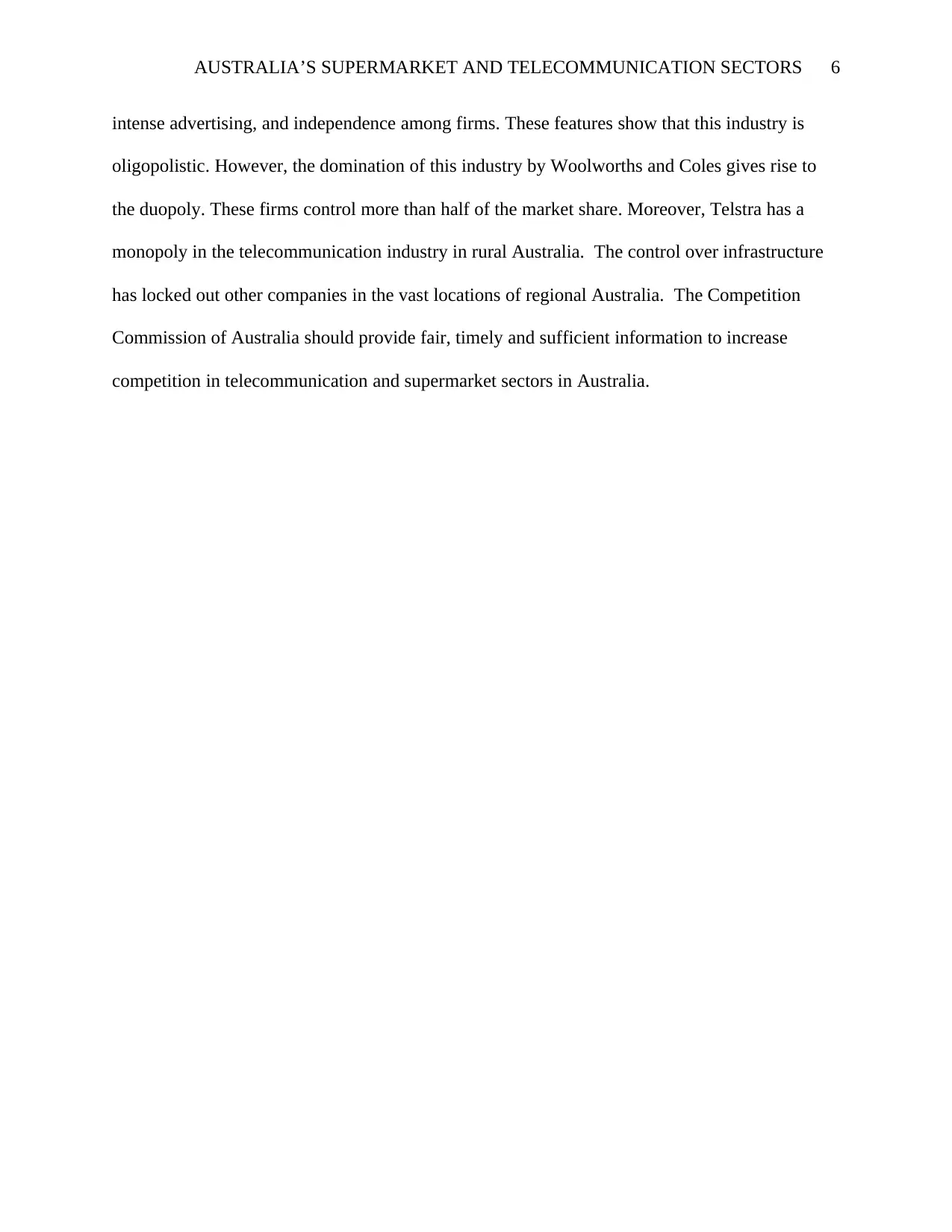
AUSTRALIA’S SUPERMARKET AND TELECOMMUNICATION SECTORS 6
intense advertising, and independence among firms. These features show that this industry is
oligopolistic. However, the domination of this industry by Woolworths and Coles gives rise to
the duopoly. These firms control more than half of the market share. Moreover, Telstra has a
monopoly in the telecommunication industry in rural Australia. The control over infrastructure
has locked out other companies in the vast locations of regional Australia. The Competition
Commission of Australia should provide fair, timely and sufficient information to increase
competition in telecommunication and supermarket sectors in Australia.
intense advertising, and independence among firms. These features show that this industry is
oligopolistic. However, the domination of this industry by Woolworths and Coles gives rise to
the duopoly. These firms control more than half of the market share. Moreover, Telstra has a
monopoly in the telecommunication industry in rural Australia. The control over infrastructure
has locked out other companies in the vast locations of regional Australia. The Competition
Commission of Australia should provide fair, timely and sufficient information to increase
competition in telecommunication and supermarket sectors in Australia.
⊘ This is a preview!⊘
Do you want full access?
Subscribe today to unlock all pages.

Trusted by 1+ million students worldwide
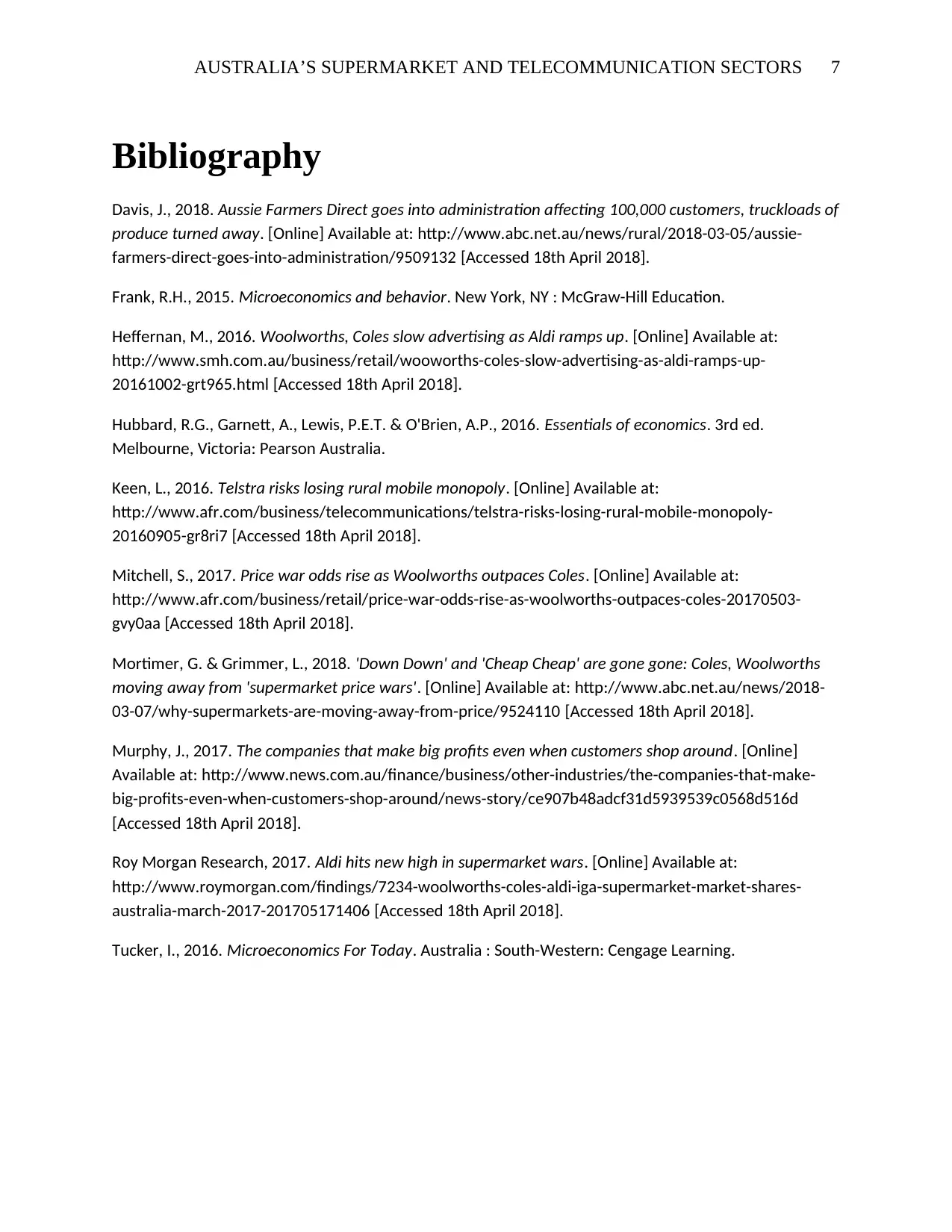
AUSTRALIA’S SUPERMARKET AND TELECOMMUNICATION SECTORS 7
Bibliography
Davis, J., 2018. Aussie Farmers Direct goes into administration affecting 100,000 customers, truckloads of
produce turned away. [Online] Available at: http://www.abc.net.au/news/rural/2018-03-05/aussie-
farmers-direct-goes-into-administration/9509132 [Accessed 18th April 2018].
Frank, R.H., 2015. Microeconomics and behavior. New York, NY : McGraw-Hill Education.
Heffernan, M., 2016. Woolworths, Coles slow advertising as Aldi ramps up. [Online] Available at:
http://www.smh.com.au/business/retail/wooworths-coles-slow-advertising-as-aldi-ramps-up-
20161002-grt965.html [Accessed 18th April 2018].
Hubbard, R.G., Garnett, A., Lewis, P.E.T. & O'Brien, A.P., 2016. Essentials of economics. 3rd ed.
Melbourne, Victoria: Pearson Australia.
Keen, L., 2016. Telstra risks losing rural mobile monopoly. [Online] Available at:
http://www.afr.com/business/telecommunications/telstra-risks-losing-rural-mobile-monopoly-
20160905-gr8ri7 [Accessed 18th April 2018].
Mitchell, S., 2017. Price war odds rise as Woolworths outpaces Coles. [Online] Available at:
http://www.afr.com/business/retail/price-war-odds-rise-as-woolworths-outpaces-coles-20170503-
gvy0aa [Accessed 18th April 2018].
Mortimer, G. & Grimmer, L., 2018. 'Down Down' and 'Cheap Cheap' are gone gone: Coles, Woolworths
moving away from 'supermarket price wars'. [Online] Available at: http://www.abc.net.au/news/2018-
03-07/why-supermarkets-are-moving-away-from-price/9524110 [Accessed 18th April 2018].
Murphy, J., 2017. The companies that make big profits even when customers shop around. [Online]
Available at: http://www.news.com.au/finance/business/other-industries/the-companies-that-make-
big-profits-even-when-customers-shop-around/news-story/ce907b48adcf31d5939539c0568d516d
[Accessed 18th April 2018].
Roy Morgan Research, 2017. Aldi hits new high in supermarket wars. [Online] Available at:
http://www.roymorgan.com/findings/7234-woolworths-coles-aldi-iga-supermarket-market-shares-
australia-march-2017-201705171406 [Accessed 18th April 2018].
Tucker, I., 2016. Microeconomics For Today. Australia : South-Western: Cengage Learning.
Bibliography
Davis, J., 2018. Aussie Farmers Direct goes into administration affecting 100,000 customers, truckloads of
produce turned away. [Online] Available at: http://www.abc.net.au/news/rural/2018-03-05/aussie-
farmers-direct-goes-into-administration/9509132 [Accessed 18th April 2018].
Frank, R.H., 2015. Microeconomics and behavior. New York, NY : McGraw-Hill Education.
Heffernan, M., 2016. Woolworths, Coles slow advertising as Aldi ramps up. [Online] Available at:
http://www.smh.com.au/business/retail/wooworths-coles-slow-advertising-as-aldi-ramps-up-
20161002-grt965.html [Accessed 18th April 2018].
Hubbard, R.G., Garnett, A., Lewis, P.E.T. & O'Brien, A.P., 2016. Essentials of economics. 3rd ed.
Melbourne, Victoria: Pearson Australia.
Keen, L., 2016. Telstra risks losing rural mobile monopoly. [Online] Available at:
http://www.afr.com/business/telecommunications/telstra-risks-losing-rural-mobile-monopoly-
20160905-gr8ri7 [Accessed 18th April 2018].
Mitchell, S., 2017. Price war odds rise as Woolworths outpaces Coles. [Online] Available at:
http://www.afr.com/business/retail/price-war-odds-rise-as-woolworths-outpaces-coles-20170503-
gvy0aa [Accessed 18th April 2018].
Mortimer, G. & Grimmer, L., 2018. 'Down Down' and 'Cheap Cheap' are gone gone: Coles, Woolworths
moving away from 'supermarket price wars'. [Online] Available at: http://www.abc.net.au/news/2018-
03-07/why-supermarkets-are-moving-away-from-price/9524110 [Accessed 18th April 2018].
Murphy, J., 2017. The companies that make big profits even when customers shop around. [Online]
Available at: http://www.news.com.au/finance/business/other-industries/the-companies-that-make-
big-profits-even-when-customers-shop-around/news-story/ce907b48adcf31d5939539c0568d516d
[Accessed 18th April 2018].
Roy Morgan Research, 2017. Aldi hits new high in supermarket wars. [Online] Available at:
http://www.roymorgan.com/findings/7234-woolworths-coles-aldi-iga-supermarket-market-shares-
australia-march-2017-201705171406 [Accessed 18th April 2018].
Tucker, I., 2016. Microeconomics For Today. Australia : South-Western: Cengage Learning.
1 out of 7
Related Documents
Your All-in-One AI-Powered Toolkit for Academic Success.
+13062052269
info@desklib.com
Available 24*7 on WhatsApp / Email
![[object Object]](/_next/static/media/star-bottom.7253800d.svg)
Unlock your academic potential
Copyright © 2020–2025 A2Z Services. All Rights Reserved. Developed and managed by ZUCOL.




